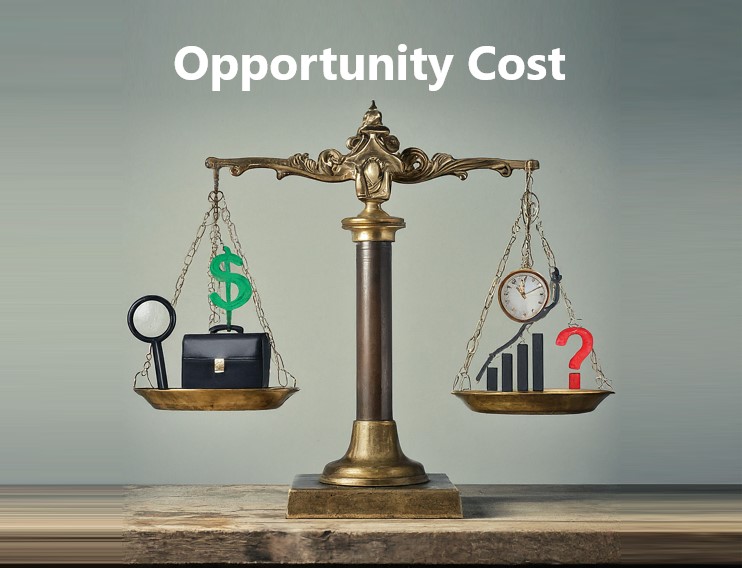
What is Opportunity Cost?
Opportunity Cost refers to the value of the next best alternative that is forgone when making a choice. In business, it represents the benefits that could have been gained if a different decision had been made. This concept helps companies understand the potential trade-offs when allocating resources, whether it’s time, money, or effort. By considering this, decision-makers can make more informed choices, prioritizing the option that offers the greatest overall benefit.
For businesses, it plays a crucial role in strategic planning and resource allocation. Companies often have limited resources, such as capital and labor, which forces them to choose between different projects or investments. By evaluating the potential returns of various options, businesses can determine which choice will yield the highest value. For example, a company may need to decide whether to invest in new product development or expand marketing efforts. Understanding the Opportunity Cost of each option allows the company to weigh potential gains and losses from alternative paths.
In personal finance, it influences decisions like saving, investing, or spending money on goods and services. Individuals constantly face trade-offs, such as choosing between spending money now or saving for the future. By recognizing the Opportunity Cost of each choice, people can make more rational decisions that align with their long-term goals. Ultimately, it’s an essential concept in both business and everyday life, helping to guide decisions toward maximizing potential value.
The Importance of Opportunity Cost in Business
Opportunity Cost is a critical factor in business decision-making, as it helps companies evaluate choices and allocate resources effectively. By understanding the value of the next best alternative, businesses can assess the potential benefits and costs associated with different options. This allows decision-makers to choose the path that maximizes returns while minimizing wasted resources. Whether a company is deciding between investing in a new project or expanding its existing operations, it provides a framework for making informed choices that align with long-term goals.
For example, a company with a limited budget may face the decision of whether to invest in research and development (R&D) or marketing. If the company chooses to invest in R&D, the Opportunity Cost is the potential revenue that could have been generated through increased marketing efforts. On the other hand, if it decides to prioritize marketing, the Opportunity Cost would be the innovation and new products that R&D could have produced. Understanding this trade-off helps businesses make strategic decisions that optimize their use of limited resources.
It also plays a role in decisions involving production capacity, hiring, or entering new markets. For instance, if a manufacturer chooses to produce one product over another, the Opportunity Cost is the potential profit from the unproduced item. By evaluating these trade-offs, businesses can avoid inefficiencies and make choices that provide the greatest benefit. Ultimately, Opportunity Cost ensures that businesses use their resources in ways that drive the most value. This improves overall performance and competitiveness.
Opportunity Cost vs. Explicit Costs
Opportunity Cost and explicit costs represent two distinct yet important concepts in business decision-making. Explicit costs, also known as direct costs, are the actual monetary expenses a business incurs. These could be wages, rent, materials, or utilities. These costs are easily identifiable and recorded in financial statements, making them straightforward to calculate. On the other hand, Opportunity Cost is the value of the next best alternative that is sacrificed when making a decision. Unlike explicit costs, Opportunity Costs are not reflected on financial statements. However, they are just as vital in evaluating the true cost of a decision.
The primary difference between the two lies in how they are measured and recognized. While explicit costs directly impact a company’s cash flow, Opportunity Costs represent foregone opportunities or potential gains that could have been realized by choosing a different path. For example, a business may invest $100,000 in new machinery, which represents the explicit cost. The Opportunity Cost, however, could be the revenue the company could have earned if it had invested that same money in a marketing campaign or a different project. Understanding both costs ensures that decision-makers have a comprehensive view of the financial and strategic implications of their choices.
Both are crucial for making informed business decisions. While explicit costs help businesses manage their day-to-day expenses, Opportunity Cost provides insight into the potential benefits or trade-offs of different decisions. By considering both, companies can avoid tunnel vision. This ensures they make choices that align with their broader goals and maximize overall value. In this way, Opportunity Cost complements explicit cost analysis, leading to more strategic and well-rounded decision-making.
Examples in Everyday Business Scenarios
Opportunity Cost is a crucial concept that businesses regularly encounter in their decision-making processes. One common example occurs when companies decide how to allocate their financial resources. For instance, a tech company might face the choice between investing in product development or expanding its marketing efforts. If it chooses to invest in product development, the Opportunity Cost is the potential new customers that a larger marketing campaign could have attracted. In this case, the trade-off lies in whether immediate customer acquisition or long-term product innovation provides greater value.
Another real-world example of this occurs when businesses decide between hiring new employees or investing in automation technologies. A manufacturing company may have the budget to either hire additional staff to increase production or invest in automated machinery. If the company opts to invest in automation, the Opportunity Cost is the potential output and efficiency that additional employees might have provided in the short term. On the flip side, hiring more staff may limit the company’s ability to enhance productivity through technology in the long run. In such situations, understanding the Opportunity Cost allows the business to make decisions that align with its long-term growth strategy.
It also plays a role in decisions involving business expansion. A retailer, for example, may need to choose between opening a new store in a growing market or focusing on e-commerce development. If the company chooses the physical store, it sacrifices the potential revenue it could have generated through a stronger online presence. These scenarios highlight how businesses constantly face trade-offs between competing alternatives. By understanding Opportunity Cost, they can make decisions that maximize value over time.
How to Calculate and Incorporate Opportunity Cost in Decision-Making
To calculate Opportunity Cost, you compare the potential benefits of different choices to determine what you sacrifice by selecting one option over another. A simple method is to identify the potential return of the next best alternative and subtract it from the chosen option’s expected return. For example, if a company decides to invest $100,000 in a new product, but the alternative investment could have earned $120,000, the Opportunity Cost of choosing the product development is $20,000. This calculation helps businesses quantify the cost of their decision in terms of forgone opportunities.
Incorporating this into business decision-making can enhance both financial and strategic planning. Businesses can integrate this concept by regularly comparing the potential outcomes of various investments, projects, or resource allocations. By including Opportunity Cost in cost-benefit analyses, companies ensure that they are considering all relevant factors before making significant decisions. This approach helps businesses avoid tunnel vision and makes it easier to identify which options provide the greatest value over time.
It should also be a core part of strategic planning. Companies can factor it into their long-term growth strategies by continuously evaluating the trade-offs between immediate gains and future opportunities. For instance, when deciding between short-term revenue increases and long-term investments, businesses that calculate Opportunity Cost are more likely to make decisions that align with their overarching goals. By consistently considering Opportunity Cost, businesses can optimize resource allocation, improve financial performance, and ensure they are pursuing the best available opportunities.
Conclusion
In conclusion, Opportunity Cost is an essential concept for businesses seeking to make informed decisions about resource allocation and strategy. By understanding the trade-offs between different options, companies can ensure they are choosing the most valuable path forward. Calculating Opportunity Cost allows businesses to weigh potential benefits and identify the true cost of each decision. Whether evaluating investments, projects, or growth opportunities, incorporating this into decision-making leads to better long-term outcomes. Ultimately, recognizing the hidden costs of forgone alternatives helps businesses optimize performance and achieve their strategic objectives.


